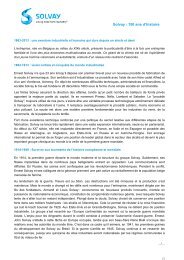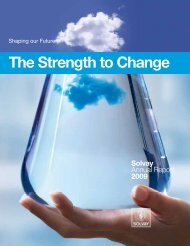THE FUTURE, - Solvay
THE FUTURE, - Solvay
THE FUTURE, - Solvay
You also want an ePaper? Increase the reach of your titles
YUMPU automatically turns print PDFs into web optimized ePapers that Google loves.
NS<br />
Micro-algae for capturing CO 2<br />
CO 2 , BIOFUEL ... <strong>THE</strong> POTENTIAL OF MICRO-ALGAE IS SEDUCTIVE AND FITS PERFECTLY WITH <strong>THE</strong> NEW<br />
BUSINESS DEVELOPMENT STRATEGY.<br />
Micro-algae attract lots of attention<br />
today, including <strong>Solvay</strong>’s! Antoine<br />
Amory, CC Advanced Technologies,<br />
who heads up the ‘micro-algae’<br />
working group on the green chemistry<br />
platform: “These micro-organisms<br />
have enormous potential! More than<br />
their use to produce biofuel, it is their<br />
ability to absorb CO2 through<br />
photosynthesis which <strong>Solvay</strong> is<br />
interested in. If one day we are going<br />
to be taxed on our CO2 emissions, it<br />
is important to limit them. Micro-algae<br />
are very prolific, sometimes thirty<br />
times more than the average for other<br />
New international<br />
partnership<br />
<strong>Solvay</strong> has launched a Global Discovery Program<br />
with fi ve partners: the Georgia Institute of<br />
Technology (Center for Organic Photonics and<br />
Electronics), Princeton University (New Jersey)<br />
and the University of Washington (Seattle)<br />
in the United States, Imperial College London<br />
(UK) and the Institute of Chemistry of<br />
the Chinese Academy of Sciences<br />
in Beijing (China). The main area of<br />
research is organic transistors<br />
(soft chips), along with research<br />
into organic photovoltaic cells<br />
(fl exible solar panels).<br />
plants. Micro-algae can be also<br />
grown on arid land, which means they<br />
don’t compete with food crops.”<br />
OBSERVE AND EVALUATE<br />
For the moment, <strong>Solvay</strong> is keeping a<br />
close watch on research in this area.<br />
“The current problem of micro-algae<br />
is the exploitation technology, and<br />
especially its cost. Today, we are<br />
interested in start-ups that are<br />
seeking solutions to the problem, for<br />
example by simultaneously taking<br />
advantage of the capabilities of algae<br />
to both absorb CO2 and to purify<br />
<strong>Solvay</strong> has invested EUR 1.49 million<br />
in ACAL Energy, a British company<br />
founded in 2004, which is proposing<br />
to replace the platinum cathode in fuel<br />
cells by its own liquid electrolytes,<br />
which are cheaper, more reliable and<br />
last longer. This technology<br />
breakthough, called FlowCath R,<br />
GROUP > Panorama<br />
water. And if their project looks to us<br />
to be scientifically and financially<br />
feasible, we could end up concluding<br />
a research partnership.” Nor is a<br />
project that is not exploitable today<br />
necessarily condemned to oblivion.<br />
“We are working with medium and<br />
long term horizons”, says Antoine<br />
Amory. “What is not viable today may<br />
be tomorrow. Because technology<br />
and market conditions change, and<br />
also because <strong>Solvay</strong> could, why not,<br />
one day supplement its portfolio with<br />
products manufactured from essentially<br />
renewable raw materials.”<br />
Breakthrough innovation<br />
in fuel cells<br />
SOLVAY IS INVESTING IN A BRITISH COMPANY WHICH HAS DEVELOPED<br />
TECHNOLOGY THAT REDUCES <strong>THE</strong> USE OF PRECIOUS METALS IN<br />
CATALYSTS.<br />
signifi cantly reduces the cost of fuel<br />
cells and will therefore accelerate their<br />
deployment on the market. For<br />
Leopold Demiddeleer, who heads up<br />
‘Future Businesses’ at <strong>Solvay</strong>, “this<br />
investment is in line with our strategy<br />
of maximizing the value of our<br />
SolviCore joint venture, which could<br />
adjust its offering of membrane<br />
electrode assemblies to include this<br />
technology breakthrough if it proves a<br />
winner.” ACAL Energy intends to<br />
present this year a demonstration fuel<br />
cell producing 1 kW of energy,<br />
enabling it to target the stationary<br />
micro-residential market.<br />
<strong>Solvay</strong> live - JULY 2009 - 7




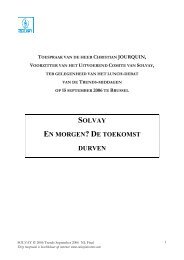
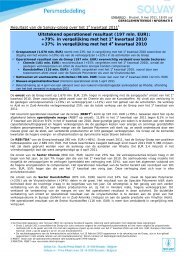

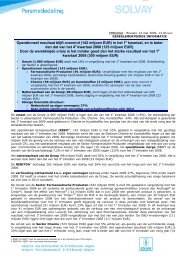


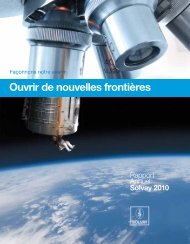
![PROC.1 [LETTRE] - Solvay](https://img.yumpu.com/16585746/1/184x260/proc1-lettre-solvay.jpg?quality=85)
